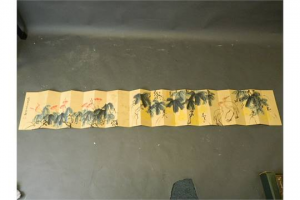Through our exploration of Jun-Fei Ji’s intimate, artistic universe, I was fascinated by his use of scrolls as a medium for storytelling. When compared to today’s ‘book’, I feel the scroll presents a fascinating platform in which to explore the boundaries of narrative. So why don’t we use tactile scrolls anymore (besides when replicating the traditional style)?
Like, why? Scrolls are awesome.
The invention of the codex spelt the end for scrolls. Some of the supposed “advantages” of using a codex were the ease of bookmarking (or indexing through pagination), the protective cover, the ability to have text on both sides of the material, and its economical capacity to be reproduced in a more compact text for convenient religious reflection (think Book of Hours). Yet, no one asks what we lost in adopting the codex as the conventional ‘book’.
In speaking with Professor Serrano, the scroll, when viewed as ‘a book with only one page’, raises fascinating temporal possibilities for the author. As the images transcend between each other, the story can be both read backwards and forwards, from the middle outwards etc. The opportunities are endless. And this is not even considering the meta-fictional possibilities: Why not have texts on both sides of the scroll? Why not have the scrolls loop back around to the beginning and have a never-ending story? Or cut holes in the scroll and have the words fall through to the other side? And so on.
You see, the scrolls identity as a traditional artifact, as almost a sculpture, both constrains and liberates it as a medium for narrative in contemporary society. Its traditional identity pigeonholes it as purely historical (Yun-Fei Ji scrolls are in the traditional style) and yet the scroll is filled with creative possibilities, as it is simultaneously viewed as both sculpture and narrative.
Of course, scrolls still exist today, both as religious objects (i.e. hanging scrolls) and in a digital capacity as we scroll down our computer screen. But the tactile scroll no longer exists, outside of the traditional aesthetic, as a medium for contemporary narratives or academic papers or, indeed, art in general. I would love nothing more than to see the Burke Library filled with both books and modern scrolls!
But the codex wins out over the scroll because we privilege the notion of pagination as a good thing. Julius Caesar famously made his scrolls into concertinas for ease of reading and we do the same today for the modern concept of a codex. Today’s book is, in many ways, just a concertina scroll.
Concertina Scroll:
But don’t we always say that we want to get lost in a story? Is there not something wonderful about knowing you may never be able to find your way back to what you’re reading (at least without significant effort)?
In the same way that we see rainbows and not the sky, we might love a story more if it too is fleeting.

